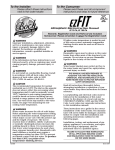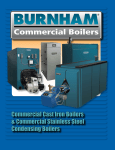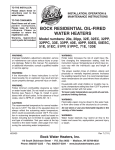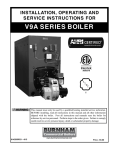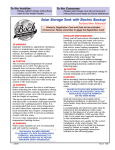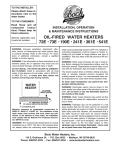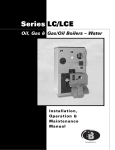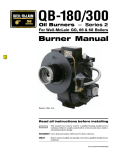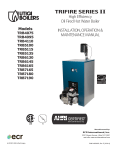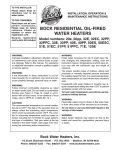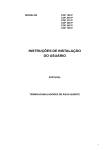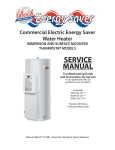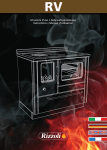Download Bock Water heaters 150 User's Manual
Transcript
TO THE CONSUMER: Read these and all component instructions. Please keep for future reference. TO THE INSTALLER: Please attach these instructions next to the water heater. INSTALLATION, OPERATION & MAINTENANCE INSTRUCTIONS GAS, OIL & DUAL FUEL WATER HEATERS 150 • 200 • 250 Warranty and registration card included WARNING: Improper installation, adjustment, alteration, service or maintenance can cause serious injury or property damage. Refer to this manual. For assistance or additional information, consult a qualified installer or service agency. always reflect the outcoming water temperature, which could occasionally exceed 120°F. The variation in outcoming temperature could be based on factors including but not limited to usage patterns and type of installation. Test your water at the tap nearest to the water heater. WARNING: If the information in these instructions is not followed exactly, fire or explosion may result and can cause property damage, personal injury or death. WARNING: Hotter water increases the risk of scald injury. Before changing the temperature setting, read the instruction manual. Temperatures at which injury occurs vary with the individual’s age and length of exposure. DO NOT INSTALL THE WATER HEATER ON COMBUSTIBLE FLOORING. Install in accordance with all local codes. In the absence of local codes, refer to NFPA 31 or ANSI Z21.10.1, or contact Bock Water Heaters with questions concerning proper flooring materials. The slower reaction times of children, elderly and physically or mentally impaired persons increases the scalding hazard to them. It is recommended lower water temperatures be used where these situations exist. To lower water temperature use point-of-use temperature limiting devices. WARNING: Flammable vapors may be drawn to this water heater from other areas of the structure by air currents. Do not store or use any flammable liquids in the vicinity of this heater. WARNING: Water heater blankets may restrict air flow to the heater and cause fire, asphyxiation, personal injury or death. Minimum clearance to combustible construction is: SIDES 6”; BACK 6”; FRONT 24”. The installation of this water heater must conform with local codes and ordinances. In the absence of local codes, the installation must comply with the National Fire Protection Association (NFPA 31) Code. WARNING: The recommended temperature for normal residential use is 120°F. The dial on the aquastat does not WARNING: Hydrogen gas can be produced in a hot water system that had not been used for an extended period-generally, two weeks or longer. To prevent possible injury under this situation, we recommend that a hot water faucet be wide open for several minutes before you use ANY electrical appliance that is connected to the hot water system. If hydrogen is present, an unusual sound – such as air escaping – will come from the open faucet as the hot water begins to flow. Hydrogen gas is extremely flammable – there must be no open flame near this open faucet. Bock Water Heaters, Inc. 110 S. Dickinson St. • P.O. Box 8632 • Madison, WI 53708-8632 Phone: 608/257-2225 • Fax: 608/257-5304 • www.bockwaterheaters.com SPECIFICATIONS Leave ample room for servicing when the water heater is installed – do not block access to the burner, inspection door, handholes or controls. Leave room to pipe the unit and connect the fuel and electricity. BURNER SPECIFICATIONS Bock MultiFlue Series 150-400 150-600 150-800 200-450 200-650 200-850 200-1150 250-800 250-1000 250-1250 250-1500 Nominal Storage 176 gal. 8 in. 3 4 168 gal. 8 in. 5 4 160 gal. 10 in. 7 6 221 gal. 8 in. 3 4 212 gal. 8 in. 5 4 204 gal. 10 in. 7 6 192 gal. 12 in. 10 10 273 gal. 10 in. 7 6 260 gal. 12 in. 10 8 251 gal. 14 in. 12 10 242 gal. 14 in. 14 11 150E-600 150E-800 200E-450 200E-650 200E-850 200E-1150 250E-800 250E-1000 250E-1250 250E-1500 4.5 gph 600000 Wayne EH 4.5 x 80B 371-028 6.0 gph 800000 Wayne EH 5.5 x 80A 193-020 3.2 gph 450000 Wayne EH 3.0 x 80B 371-028 4.6 gph 650000 Wayne EH 4.5 x 80B 371-028 6.1 gph 8.2 gph 6.0 gph 7.1 gph 9.0gph 11.0 gph 850000 1150000 800000 1000000 “1,250,000” 1500000 Wayne Wayne Wayne Wayne Wayne PowerFlame EH FH EH FH FH C2-OAS 6.0 x 70B 2-4.0 x 80B 6.0 x 70B 2-3.5 x 80B 2-4.5 x 80B 6.00x70B* 193-020 193-022 193-020 193-022 193-022 Carlin Carlin 201 CRD 301 CRD 2.5 x 70B* 4.0 x 80B* Carlin 301 CRD Carlin Carlin 201 CRD 301 CRD 2.5 x 70B* 4.0 x 80B* Stack Size, in. Turboflues, Qt. Anode Rods, Qt. Bock Oil 150E-400 Fired Model Max. Fire Rate 3.0 gph Btu/hr input 400000 Burner Make Wayne Model EH Nozzle 3.0 x 80A OEM Number 371-026B Burner Make Model Nozzle OEM Number 9828500B361E Bock Dual 150DF-400 Fuel Model Max. Fire Rate 3.0 gph Btu/hr input 400000 9859400B 5.0 x 80A or 70W* 9859400B Btu/hr input 400000 J15A-10 5.0 x 80A or 70W* 9859400B 9859400B 200DF-450 200DF-650 200DF-850 200DF-1150 250DF-800 4.5 gph 600000 6.0 gph 800000 3.2 gph 450000 4.6 gph 650000 6.1 gph 850000 8.2 gph 1150000 6.0 gph 800000 150G-600 150G-800 600000 800000 Burner Make Power Flame Power Flame Power Flame Model 5.0 x 80A or 70W* 150DF-800 C1-GO-10 C1-GO-10 C1-GO-10 1.65x70B* 2.50x70B* 3.25x70B* Bock Power 150G-400 Gas Model 9859400B Carlin 301 CRD 150DF-600 Burner Make Power Flame Power Flame Power Flame Model Nozzle 9828500B361E Carlin 301 CRD J15A-10 J30A-10 250DF-1000 250DF-1250 250DF-1500 7.1 gph 1000000 11.0 gph 1500000 Power Flame Power Flame Power Flame Power Flame Power Flame Power Flame Power Flame Power Flame C1-GO-10 C1-GO-10 C1-GO-10 C1-GO-12 C1-GO-10 C1-GO-12 C1-GO-12 C2-GO-15 1.75x80B* 2.50x70B* 3.5x70B* 4.50x70B* 3.25x70B* 4.0x70B* 5.00x70B* 6.00x70B* 200G-450 200G-650 450000 650000 200G-850 200G-1150* 250G-800 250G-1000 250G-1250* 250G-1500 850000 1150000 800000 1000000 “1,250,000” 1500000 Power Flame Power Flame Power Flame Power Flame Power Flame Power Flame Power Flame Power Flame J15A-10 J15A-10 Burner Controls: Burner Primary Control Wayne EH R8184G 1294 PF C2-0AS RM7895C 1012 PF C1-GO-10,12,15 RM7895C 1012 CARLIN 201CCRD, 301CRD P/N 4020002 J30A-10 J30A-12 J30A-10 J30A-10 Detector C554A C7072A C7072A C1440700K Aquastats: High Limit Honeywell Model L4080 & Averaging Control Model L8100C. Flue Tubes: Flue tubes constructed of steel minimum, 1/8 in. thick, 6 in. OD by 35 in. long, and provided with fins welded in a spiral pattern. Model 150-400 200-450 150-600 200-650 150-800 200-850 200-1150 250-1250 250-1500 9.0 gph 1,250,000 Number of Flues 3 3 5 5 7 7 10 12 14 J30A-12 C2-G-15 WARNING Improper installation, adjustment, alteration, service or maintenance can cause serious injury or property damage. Refer to this manual. For assistance or additional information, consult a qualified installer or service agency. WARNING If the information in these instructions is not followed exactly, fire or explosion may result and can cause property damage, personal injury or death. CAUTION Do not install on combustible flooring. Minimum clearance to combustible construction is: SIDES: 6”; BACK: 6”; FRONT: 24”. Install in accordance with all local codes. In the absence of local codes, refer to National Fuel Gas Code and/or NFPA 31 or ANSI Z21.10.1. WATER PIPING Install unions and shut-off valves on both hot and cold water lines. A temperature and pressure (T&P) relief valve has been installed at the factory. Install a discharge line from the relief valve outlet to a suitable drain. Arrange the line without restriction to allow for complete drainage of both the relief valve and line. Do not install a check valve in the cold water line. If backflow preventers or pressure regulators are installed, be sure to make provision for expansion of water when heated by installing either a thermal expansion valve or an expansion tank in the system. GAS PIPING All piping must comply with local codes/ordinances or National Fuel Gas Code & NFPA No. 54 Install a sediment trap or drip leg in the supply line to the burner. Install a union in the gas line adjacent to and upstream from the control manifold and downstream from the manual main shut-off valve. A 1/8” NPT plugged tapping accessible for test gauge connection must be installed immediately upstream of the gas supply connection to determine the gas supply pressure to the burner. Install a manual shut-off valve in the gas supply line external to the water heater. The gas line should be a separate supply direct from the meter to the burner. Use new pipe that is free of cutting burrs and well-supported. Use pipe dope (approved for all gasses) on male threads only. When pressure testing the gas supply piping system at less that 1/2 psig., close the manual gas shut-off valve to the heater. If test pressures are to exceed 1/2 psig., the water heater and its manual shut-off valve must be disconnected from the system. Be sure gas service and meter are adequately sized. OIL PIPING All heaters covered by this manual are equipped with two-stage fuel pumps. They require a two pipe system, suction and return. The fuel pumps have the bypass plug installed, which requires a twopipe system using 5/8” O.D. soft copper tubing. For gravity flow system (oil supply above the burner), if a one-pipe system is used the bypass plug should be removed. On the larger burners and all dual fuel burners, a two-pipe system is required. For multiple heater installations, run a separate suction and return line for each heater if possible. Where the combined lift in feet and horizontal run exceeds 100’, install a booster pump as near to the supply tank as possible. Return lines must be the same diameter as suction lines and extend close to the bottom of the storage tank, but stop slightly above the suction lines. Use a minimum of fittings, making bends in tubing with as large a radius as possible. Always use flared fittings, not compression fittings. If pipe is used instead of tubing, do not connect the burner to the pipe – use copper tubing and form a coil before attaching to the burner. MOUNTING THE BURNER The burner is shipped separately. Unpack and examine to be sure the unit is in good condition. Install on the water heater using the mounting bolts provided. On larger burners, an additional pedestal is supplied to support the burner. Make sure there are no obstructions in front of the burner and that the burner is not protruding into the combustion area. CONNECT TO THE CHIMNEY Using “L” or “A” type venting, connect the heater to the chimney. Do not reduce the smoke pipe diameter; use the same size smoke pipe as the heater flue pipe. Run a separate connector from the heater to the chimney where possible. If the heater must be joined to another oil appliance breaching before going into the chimney, enlarge the existing breaching to accommodate the extra volume of gases from the heater. The entrance into the breaching should be at a 45° angle. COMBUSTION AIR Adequate, non-contaminated combustion air must be supplied to the water heater. In a confined space with a volume of less than 50 cubic feet per 1000 BTUH, the space must be vented at the floor for combustion air, and at the ceiling for ventilation. The air can be supplied from either inside or outside of the building as conditions allow. VENTILATION AIR NOTE: All ducts must have the same cross sectional area as the free area of each opening to which they connect. The minimum side dimension of a rectangular duct must be no smaller than three (3) inches. Caution: Operation of exhaust fans, ventiliating systems, power burners, induced draft systems, or fireplaces may create conditions that require special attention to avoid unsatisfactory operation of installed equipment. Care must be taken to insure an adequate air supply for the water heater. A. Install equipment only where the water heater will have satisfactory combustion, proper venting and the maintenance of temperature at safe limits all around the unit under normal operating conditions. Free circulation of air around the water heater is essential. If the air supply is inadequate, introduce outside air. Any temperature above 90°F around the heater indicates a need for additional air (see NFPA 31 for air requirements). B. In addition to air needed for combustion, air may be required for draft control; cooling off; controlling dew point; heating; drying; oxidation or dilution; safety exhaust; odor control; and compressors. C. Make sure air around the water heater is adequate for personal comfort and working conditions. D. Check for proper draft. Place a draft gauge in the chimney above the draft diverter. Drafts should be at least -0.02” W.C. and less than -0.05” W.C. while the water heater is in operation. Unconfined space: No additional combustion and ventilation air is required if the volume of the space is greater than 50 cubic feet per 1,000 BTUH of the combined total input of all equipment installed in that space. Rooms leading directly to the space through openings which cannot be closed are considered part of the unconfined space. Confined space: When the unit will be installed in a space with a volume of less than 50 cubic feet per 1,000 BTUH, the space must be vented at the floor for combustion air and at the ceiling for ventilation. This air can be supplied from either inside or outside of the building as conditions allow (refer to NFPA 31 or local codes). A. Inside air supply: Provide two permanent openings; one within 12” of the top of the enclosure and one within 12” of the bottom, leading directly to room(s) of sufficient volume so that the combined volume of all the space meets the criteria for unconfined space. Each opening required a minimum free area of one (1) square inch (two square inches total) per 1,000 BTUH of the combined total input of all equipment installed in the enclosure, but not less than 100 square inches. B. Outside air supply: Provide two permanent openings; one within 12” of the top of the enclosure and one within 12” of the bottom. These openings must lead directly to crawl and attic spaces leading directly to the outside of the building. 1. Leading directly to outside or through vertical ducts: Each opening (top and bottom) requires a minimum free area of one (1) square inch (two square inches total) per 4,000 BTUH of the combined total input of all equipment installed in the enclosure. 2. Leading to the outside through horizontal ducts: Each opening (top and bottom) requires a minimum free area of one (1) square inch (two square inches total) per 2,000 BTUH of the combined total input of all equipment in the enclosure. Louvers and grilles: In calculating the “free” area in Equipment Located in Confined Spaces, consider the blocking effects of louvers, grilles, or screens protecting openings. The screens cannot be smaller than one (1) inch of mesh. If the “free” area of a louver or grille is known, it should be used in calculating the size opening required to provide the “free” area specified. If the design and “free” area is not known, assume wood louvers have 20% to 25% “free” area, and metal louvers and grilles 60& to 70%. Fix louvers and grilles in the open position or interlock with the equipment so they are opening automatically during equipment operation. WIRING All wiring should conform to the National Electrical Code. Install a separately fused disconnect switch for the water heater. The water heater is equipped with an immersion aquastat with dual bulbs to control operation of the heater and a separate high limit immersion control (both controls are installed and wired at the factory). A wiring harness is furnished to connect the control system to the burner control panel. Follow the wiring diagram furnished with the burner to complete the field wiring. When wiring is completed, set the operating temperature control (L8100C) to 120°F. Higher temperature setting will increase the risk of scalding. WIRING DIAGRAM: LARGE OIL W/AVERAGING P.F. GAS BURNER WIRING W/AVG. PUTTING HEATER INTO OPERATION SET DRAFT AND ADJUST BURNER COMBUSTION (see burner instructions) Fill the heater with water, opening a hot water faucet to allow trapped air to escape. Check hand holes for tightness. Check the fuel supply and all fuel lines for tightness. Rotate the blower wheel to loosen the pump shaft seal. Bleed air from the oil line by opening the bleed valve on the fuel pump. Attach a small plastic tube to the bleed valve fitting on pump and run to a gallon container. Turn on the electricity and set the thermostat sot eh burner motor runs. The heater will not ignite when the bleed valve is open. Bleed the line until the oil is completely clear (not milky or opaque), transparent and free of air bubbles and froth. 1. Start the burner and adjust draft to the -.02 in H2O to -.05 in H2O. 2. Verify that the pump pressure matches the values in the chart. 3. Check the smoke and adjust the air to give #1 smoke. 4. Readjust to give a trace or zero smoke. 5. Check that the CO2/O2 level is at 11% or higher. Note: Do no attempt to adjust the burner without instruments. 6. Open the air adjustment to lower the CO2 by .5% or 1% to allow for draft and fuel variations (refer to the burner manufacturer’s recommendations). The thermostat has been adjusted to 120°F at the factory. Wait until thermostat has shut off fuel to the main burner; wait 30 seconds following shut off of fuel, then set thermostat to the highest temperature. The main burner should re-light. Set thermostat to the lowest temperature; the main burner should go out. The thermostat should be adjusted in accordance with the local codes or to the minimum setting that will meet the hot water needs of the consumer. Bock recommends 120°F temperature settings for residential applications for safety as well as energy efficiency. 1. Check the fuel supply, electrical wiring and fuses. Make sure the temperature control is set for heat. SERVICE: Regular maintenance will keep the water heater operating at peak efficiency. The tank can fail prematurely from the accumulation of lime and sediment in the bottom, excessive pressure and/or corrosion. 2. If the motor runs but there is no flame, remove the electrode assembly, clean and readjust (see Figure 5). Check the electrode porcelain for cracks and replace if necessary. Check the transformer to see of it is producing a strong spark. (Use extreme caution – the transformer has a 10,000 volt output.) Check that the coupling between the motor and pump shaft is not slipping. Check the set screw on the blower wheel for tightness. Clean or replace the nozzle if necessary, always using the correct size and spray angle provided by the manufacturer. 3. Bleed the pump to make sure the oil is clear and free of air bubbles. If the oil is milky or frothy, check the line for air leaks at fittings. Check the oil filter gaskets and make sure the filter cartridge is clean. 4. If the burner motor does not run, check the motor thermal overload button (red) and reset. If the burner motor does not run after pushing the red button on the back of the motor, turn the motor off and check the motor shaft to see of it is tight. Check the pump shaft; if it is free and the motor will not run, replace the flame detector located in the burner housing. Turn on the current and reset the control (relay). If the motor still does not run, replace the control (relay). If motor hums and gets hot, replace the motor. 5. If the burner ignites and runs a short time (10 to 15 seconds) and goes out on safety, replace the flame detector. If the burner still runs only a short time, replace the control. 6. The smell of oil or combustion products may be caused by poor draft or lack of combustion air. Remove and clean the electrode assembly and check the draft in the connector directly above the heater. There should be at least .01 inches W.C. draft (pull) or greater. Lime and sediment: Such accumulations can be controlled to an extent by softening the water. The tank should be inspected every six months by draining the tank, removing the hand hold cover, and making a visual check of the tank interior. If lime (or sediment) has accumulated, it should be removed by use of a commercial lime dissolving chemical or by scraping loose the deposit and flushing it away through the hand hole drain. Excessive pressure is controlled by the T&P relief valve. Water expands when heated and the extra volume of water must have a place to go. If water cannot expand into the cold water line because of a check valve, pressure builds as the water heats. The pressure relief valve opens, and dumps the extra volume of water. If the relief valve is faulty or none has been installed, the tank can fail due to this excessive pressure. Open the relief valve at least once a year to make sure the seat is not stuck. Caution: Before opening the relief valve be certain that the discharge line directs the water away from anything that could damaged or would block the flow of water to the drain. Stand away from the outlet to avoid contact with the water. MAINTENANCE INSTRUCTIONS Regular maintenance will keep the water heater operating at peak efficiency. The tank can fail prematurely from an accumulation of lime and sediment on the bottom and tubes, excessive pressure and/or corrosion. Prevention will appreciably extend the life of the water heater. Lime and sediment accumulations can be controlled by softening the water. Inspect the tank every six months by draining, removing the hand hole cover and making a visual check of the interior. Remove lime or sediment with a commercial lime dissolving chemical or scrape loose the deposit and flush it away through the hand hole or drain. Excessive pressure is controlled by the pressure relief valve. Water expands when heated; if it cannot expand into the cold water line because of a check valve, the pressure relief valve opens and dumps the extra water. If the relief valve is faulty or none has been installed, the tank can fail due to this excessive pressure. Open the relief valve at least once a year to make sure the seat is not stuck. Caution: Before opening the relief valve, be certain the discharge line directs the water away from the outlet to avoid contact with the water. MAGNESIUM ANODE RODS Magnesium anode rods are installed in the head of the tank to help prevent corrosion. When inspecting the tank interior for lime, also inspect the anode rods. When the original diameter of any of the anode rods has eroded to about one-third it should be replaced. Freezing: If the water heater is to be shut off during cold weather, the tank and water lines must be drained to prevent freezing, which will crack the tank. Open the relief valve test lever annually. IMPORTANT The warranty will be invalid if the tank fails due to excessive pressure, accumulation of lime or sediment, corrosion or freezing. Clean the oil burner nozzle annually and reset the electrodes. Replace the filter cartridge on the oil supply line filter annually. LIMITED WARRANTY WARRANTY COVERAGE This warranty covers “Bock” Water Heaters models 150, 200 or 250, gas, oil or dual fuel. Bock Water Heaters, a division of Bock Corporation – a Wisconsin corporation – at 110 S. Dickinson St., Madison, WI 53703, (“Company”), warrants to the owner that the tank of this water heater will not leak due to defective materials or workmanship for THREE (3) years from the date of the original installation. The company also warrants that no other part of this water heater will fail due to a defect in material or workmanship for one (1) year. This warranty does not apply where the purchase is for resale. COMPANY RESPONSIBILITY Bock Water Heater’s responsibility is to repair or replace, at our option with the prevailing comparable model, any part of the equipment sold by the Company which proves to be defective in material or workmanship, including the tank, during the warranty period when installed in accordance with applicable codes and ordinances and operated and maintained in accordance with our instructions, subject to the conditions and exceptions indicated below. Our liability, in the event of leakage or other malfunction, is strictly limited to repair or replacement of the defective heater or part as provided herein. We are not responsible hereunder for incidental property damage or personal injury, consequential costs or damage. OWNER RESPONSIBILITY At the company’s request, the owner is to return to the factory al Madison, WI any part, including the tank, defective in material or workmanship and pay all transportation charges for such return parts and for replacement parts sent from the factory to the owner. The owner will pay all labor charges for the removal and installation of such parts, including the tank. EXCEPTIONS This warranty will not apply to tanks or parts subject to misuse, abuse, neglect, alteration, accident, excessive temperature, excessive pressure, lime, silt or sediment accumulation, corrosive atmosphere, the removal of magnesium anode rods, installation outside of the United States, or on which the serial numbers have been altered. The warranty also does not apply when the water heater is installed without a new temperature and pressure relief valve and is not installed in accordance with local codes and ordinances. TOTA L WARRANTY COMMITMENT We will not assume nor authorize any person to assume for us any other liability in connection with the sale or operation of Bock Water Heaters. Any implied warranties, including merchantability or fitness for a particular application imposed on the sale of this heather under laws of the state of sale are limited to one (1) year. Some states do not allow limitations on how long an implied warranty lasts or for the exclusion of incidental or consequential damages, so the above limitations or exclusions may not apply to the purchaser. This warranty gives specific legal rights – other rights may vary from state to state. The card should be returned within thirty (30) days of the date of installation; otherwise, the date of manufacture will be recorded as the date of installation for the purpose of this warranty. Contact your nearest Bock distributor or Bock Water Heaters • 110 S. Dickinson St. • Madison, WI 53703 Phone: 608/257-2225 • FAX: 608/257-5304 • www.bockwaterheaters.com Rev. Date 01/05 #23432








